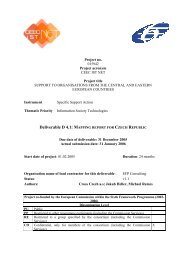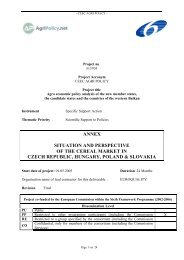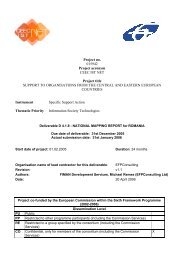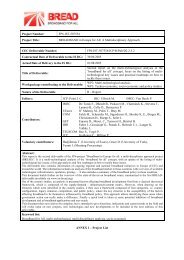Project Number: FP6-IST-507554 Project Title: BROADBAND in ...
Project Number: FP6-IST-507554 Project Title: BROADBAND in ...
Project Number: FP6-IST-507554 Project Title: BROADBAND in ...
You also want an ePaper? Increase the reach of your titles
YUMPU automatically turns print PDFs into web optimized ePapers that Google loves.
Page 20 of 319<br />
<strong>FP6</strong>-<strong>IST</strong>-<strong>507554</strong>/JCP/R/Pub/D2.2-3.2<br />
An important barrier to the development of cross-sectional content providers is that it is not enough to provide<br />
the same content on different platforms. In order to rema<strong>in</strong> competitive, content must be designed <strong>in</strong> a way that<br />
takes the potentials and limitations of each platform <strong>in</strong>to consideration. As long as the technical capabilities vary<br />
across platforms and networks, there will always be scope for development of content designed for a particular<br />
platform.<br />
Another trend is the entry of telecom operators <strong>in</strong>to the broadcast<strong>in</strong>g sector. In Denmark, for <strong>in</strong>stance, the<br />
<strong>in</strong>cumbent operator TDC (formerly TeleDanmark) tried to establish its own TV channel <strong>in</strong> the mid 1990s;<br />
Telecom NZ has bought a stake <strong>in</strong> Rupert Murdoch’s Sky Network Television; and British Telecom has recently<br />
applied for a broadcast<strong>in</strong>g license.<br />
These examples deal both with horizontal and vertical <strong>in</strong>tegration. The philosophy is to ensure content to the<br />
networks. For example, BT (formerly British Telecom) seeks to distribute its broadcast<strong>in</strong>g service via its own<br />
broadband network. However it is not yet clear whether these attempts at convergence will be successful. BT<br />
has yet to make its broadcast service profitable.<br />
6.4.4 Convergence between distribut<strong>in</strong>g companies<br />
The most important trend <strong>in</strong> convergence of distribution networks is between the telecom networks (which also<br />
provide the <strong>in</strong>frastructure for many IT services) and the broadcast<strong>in</strong>g networks. The telecom networks are used<br />
for telephony as well as data, and now Internet services. Broadcast<strong>in</strong>g services are still ma<strong>in</strong>ly distributed over<br />
separate networks, but some broadcast<strong>in</strong>g can also take place via the Internet. On the other hand, cable-TV<br />
networks can offer telecom services as well. In the UK, US and some other countries, cable operators have<br />
upgraded their cable networks to provide telephony, and cable modems are used to offer Internet access <strong>in</strong> many<br />
countries.<br />
In some countries, the <strong>in</strong>cumbent operators have from the very beg<strong>in</strong>n<strong>in</strong>g been among the major cable-TV<br />
operators. This has tended to slow down convergence as telecom operators have been hesitant to <strong>in</strong>troduce new<br />
services <strong>in</strong> the cable network (such as cable-modem access to the Internet) that compete with services delivered<br />
<strong>in</strong> the telecom networks. In the US, through its acquisitions of lead<strong>in</strong>g cable operators TCI and MediaOne,<br />
AT&T became one of the two major cable-TV operators. S<strong>in</strong>ce its divestiture from its local operat<strong>in</strong>g companies<br />
<strong>in</strong> 1984 AT&T has lacked a direct network access to its customers. Through this acquisition it sought to rega<strong>in</strong><br />
direct access.<br />
Another trend is convergence between communication network operators and operators of other types of<br />
networks. In particular electricity companies have been active <strong>in</strong> roll<strong>in</strong>g out communication facilities <strong>in</strong><br />
conjunction with their power l<strong>in</strong>es. This has <strong>in</strong> many cases proven to be a cost effective way to provide fibre to<br />
the home (FTTH).<br />
6.4.5 Convergence between equipment manufactures<br />
Convergence <strong>in</strong> equipment production is not a new phenomenon, but is essential to achieve <strong>in</strong> particular<br />
term<strong>in</strong>al and network convergence. Many <strong>in</strong>dustrial corporations such as Philips and Siemens are <strong>in</strong>volved <strong>in</strong><br />
many different <strong>in</strong>dustrial activities <strong>in</strong> most of the ICT and media sectors. The reasons for this relate primarily to<br />
strategy of conglomeration and the synergies between equipment production of different types of electronic<br />
equipment that existed before the digitalisation opportunities arose.<br />
Dur<strong>in</strong>g the past decade, convergence has been most visible <strong>in</strong> the IT and telecom sectors. The liberalisation of<br />
the telecom sector has made it possible for new entrants from IT hardware, software and consumer electronics to<br />
start up production of telecom equipment. At the same time, the technical convergence between IT and telecom<br />
equipment has made it economical to enter the telecom market. One prom<strong>in</strong>ent example is Cisco which supplies<br />
routers to private data networks as well as public telecom networks (<strong>in</strong> particular IP-networks).<br />
Convergence is not only a matter of utilisation of synergies <strong>in</strong> development and production. It is also a question<br />
of develop<strong>in</strong>g new types of equipment with features orig<strong>in</strong>at<strong>in</strong>g from different <strong>in</strong>dustries. This is clearly seen <strong>in</strong><br />
the development of term<strong>in</strong>als for digital TV. These term<strong>in</strong>als not only comb<strong>in</strong>e broadcast<strong>in</strong>g and IT technologies<br />
<strong>in</strong> their technical design. The services they provide are also a result of the convergence between the different<br />
<strong>in</strong>dustries.










